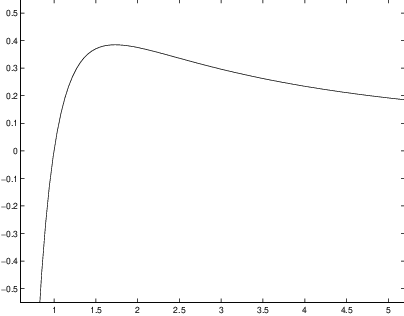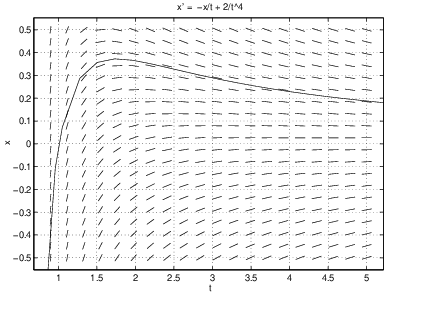The simplest nonconstant coefficient homogeneous linear differential equation is:
This equation does not have constant coefficients, since the coefficient depends on . The equation is linear as linear combinations of solutions are solutions. Note that (??) is of the form (??) and can be solved by separation of variables.If , then is the solution to the initial value problem (??). To solve the initial value problem for (??) when , we apply the technique of separation of variables to this equation, which yields where is the definite integral
Exponentiation implies that for an appropriate scalar . Indeed, if , then We have shown that the function is the unique solution to the initial value problem (??) where .An Example of a Nonconstant Coefficient Equation
We illustrate (??) by an example. Solve the initial value problem Since , we can use (??) to compute Then the solution (??) is given by
The Inhomogeneous Equation
Next, we consider forced linear differential equations of the type
where and are continuous functions of . The differential equation (??) is homogeneous when and inhomogeneous otherwise. As is always the case, we find the general solution to the inhomogeneous equation by adding the general solution to the homogeneous equation (that we can find by separation of variables) to a particular solution to the inhomogeneous equation.Two Examples of Solutions of Inhomogeneous Equations
(a) Find all solutions of the differential equation
By inspection, the constant function is a particular solution of (??). Since all solutions of the homogeneous equation are of the form for some real constant , it follows that the general solution of the inhomogeneous equation is(b) Find all solutions of the differential equation
A calculation shows that is a particular solution of (??). Since all solutions to the homogeneous equation are of the form for some real constant , it follows that the general solution of the inhomogeneous equation isInhomogeneous Equations and Variation of Parameters
In Examples (??) and (??) we guessed or were given a particular solution to the inhomogeneous equation. Now we discuss a method for finding a particular solution to the inhomogeneous equation (??) when is a nonzero function. This technique for finding a particular solution is called variation of parameters.
We already know by separation of variables that every solution of the homogeneous equation () has the form where . The idea behind variation of parameters is to allow to depend on . More precisely, assume that a solution has the form where is a differentiable function of . Substituting in (??), using the product rule for differentiation and suppressing the explicit dependence of functions on , leads to the identity which simplifies to This last equation may be solved for by integration, obtaining
Uniqueness of solutions to initial value problems implies the main result of this section.Two Examples of Variation of Parameters
(a) Solve the initial value problem
Compute Hence which implies that is the solution. For comparison we show the graph of (??) in Figure ??(left) and the result of a numerical computation of the initial value problem using dfield5 in Figure ??(right).

(b) Solve the initial value problem Here and
Exercises
In Exercises ?? – ?? decide whether or not the given differential equation is linear. If it is linear, specify whether the equation is homogeneous or inhomogeneous.
In Exercises ?? – ?? solve the given initial value problems by variation of parameters.
In Exercises ?? – ?? use dfield5 to compute solutions to the given linear differential equations. What is the asymptotic behavior of the solutions as tends to infinity? Use variation of parameters to explain the behavior.